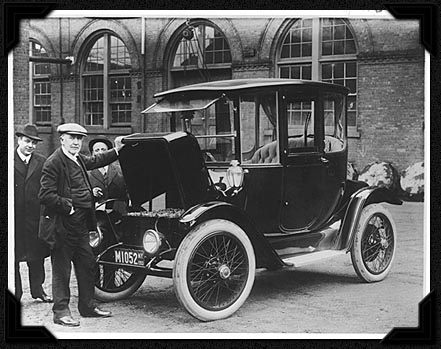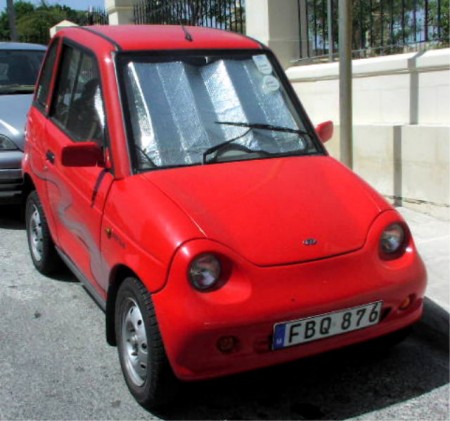Modern electric cars - the story from the beginnings to the horizons
Currently, more and more attention is paid to the human environment. The growing pressure of human activity on the environment has already led to the fact that in many cities people are used to seeing what they are breathing. The wide distribution of personal vehicles creates many problems for the organization of intra-city traffic. Modern man spends a lot of time in traffic jams, in which smoking cars create a favorable environment for the development of chronic respiratory diseases, slow movement at the speed of a cochlea requires increased attention, the probability of being late for work or an important meeting increases the already high level of stress load on the body.

Governments of developed countries have already begun to realize the gravity of the situation and impose strict environmental standards for cars, various monetary fees are introduced in congested city centers to limit traffic (“traffic jams”), various programs are being developed to support alternative modes of transport. At the moment, one of the most promising areas is the development of electric transport.
The history of electric vehicles has more than one and a half centuries - the first electric vehicle appeared in public in 1841 (much earlier than a car with an internal combustion engine). By the end of the XIX century, the number of electric vehicles exceeded the number of rustling and smoking fellow at times. At that time, the speed characteristics and the range of personal transport were not as important as ease of maintenance, quick engine start, quietness and ride comfort. Only very rich people could afford personal vehicles at that time. The electric car was a more pleasant toy for aristocracy and more attractive for visits by doctors than hellish steam or gasoline cars.
Over time, cars with internal combustion engines became cheaper and their advantages such as speed and distance of the trip led to the gradual disappearance of the first electric vehicles from public roads. The electric cars themselves, however, did not disappear - they simply began to be used in the form of a local vehicle and cargo transportation in the territories of enterprises, parks, golf clubs.
')

Nowadays, thanks to the achievements in the field of accumulation of electric power, gradually more and more attention is paid to the prospects of using electric vehicles as an intra-city transport. Already, tens of thousands of electric vehicles and millions of electric scooters, electric bicycles and other means of transportation using electricity are hopping around the cities of the world.
What are the advantages of urban electric transport, compared with cars with internal combustion engines, which allows us to speak with confidence about the future of electric vehicles? I will give a simple list:

Governments of developed countries have already begun to realize the gravity of the situation and impose strict environmental standards for cars, various monetary fees are introduced in congested city centers to limit traffic (“traffic jams”), various programs are being developed to support alternative modes of transport. At the moment, one of the most promising areas is the development of electric transport.
The history of electric vehicles has more than one and a half centuries - the first electric vehicle appeared in public in 1841 (much earlier than a car with an internal combustion engine). By the end of the XIX century, the number of electric vehicles exceeded the number of rustling and smoking fellow at times. At that time, the speed characteristics and the range of personal transport were not as important as ease of maintenance, quick engine start, quietness and ride comfort. Only very rich people could afford personal vehicles at that time. The electric car was a more pleasant toy for aristocracy and more attractive for visits by doctors than hellish steam or gasoline cars.
Over time, cars with internal combustion engines became cheaper and their advantages such as speed and distance of the trip led to the gradual disappearance of the first electric vehicles from public roads. The electric cars themselves, however, did not disappear - they simply began to be used in the form of a local vehicle and cargo transportation in the territories of enterprises, parks, golf clubs.
')

Nowadays, thanks to the achievements in the field of accumulation of electric power, gradually more and more attention is paid to the prospects of using electric vehicles as an intra-city transport. Already, tens of thousands of electric vehicles and millions of electric scooters, electric bicycles and other means of transportation using electricity are hopping around the cities of the world.
What are the advantages of urban electric transport, compared with cars with internal combustion engines, which allows us to speak with confidence about the future of electric vehicles? I will give a simple list:
- Ecological purity of the drive (zero emissions at the place of use)
The ability to stand in traffic jams, without wasting energy to keep the engine idling
Cost of use comparable to public transport costs.
High level of reliability and durability of an electric vehicle
The only option for the use of electricity generated at nuclear power plants, in personal transport
The ability to integrate into the power grid to equalize the night drop in electricity consumption
When using modern capacious rechargeable batteries, it is possible in principle to use the energy stored in an electric vehicle overnight to smooth out peaks of energy consumption during the day
Talking about the benefits of using electric vehicles, you must also indicate on the reverse side of the medal:- Electric cars have a fairly modest power reserve without recharging, which is limited by the weight and cost of the battery
When a mass transition to the use of electric vehicles will arise the problem of expanding the network of power plants - with a complete transition from motor vehicles to electric cars, it will be necessary to increase the capacity of power plants by 1.5-2 times. Accordingly, the problem will arise of increasing the number of power lines.
With the widespread use of electric vehicles, it will be necessary to significantly expand the production of batteries, as well as build a large number of enterprises for recycling used batteries.
Currently, serial electric cars are comparable in price to cars, which reduces the likelihood of their purchase.
Based on the balance of advantages and disadvantages of modern personal electric transport, it is possible to predict the intended use of electric vehicles as a mass means of intercity communication in the foreseeable future.
You can ask me: “Why are electric cars now exotic, because they have so many advantages?”. I will answer. At the moment, the world is sitting on the "oil and gas needle," like a drug addict. With the massive introduction of electric vehicles, there will be a sharp redistribution of spheres of influence in production: dependence on oil and gas companies will decrease, the level of production of motor vehicles will fall, the entire service sector of “oil curlers” will get a strong blow due to a decrease in the volume of services. There will be greater tension in society due to the increase in unemployment and the redistribution of personnel. This scenario does not satisfy either the government or oil and gas companies. Therefore, as long as there is an opportunity to receive oil and gas at a reasonable price, the development of electric vehicles will be strongly hampered.
Despite the pessimism of my recent statements, I am confident in the future of electric transport: the prices of oil and gas are rising, and the transition to the mass use of alternative modes of transport is not far off. The attitude of European countries to this problem can serve as litmus paper: various models of serial electric vehicles are increasingly being produced, legislative support is being introduced for owners of clean vehicles, and the environmental awareness of the population is growing. Electric car enthusiasts now have ample opportunity to realize their dreams - everything you need for converting a car into an electric car can be bought quite easily for relatively little money.
You can learn more information about electric cars by visiting the hobby project of the author of the article ev.sdisle.com (or the new project of the author - Dig.by ), where you can learn a lot of information regarding serial electric vehicles, read reviews about the types of batteries used in electric transport, compare the environmental and energy efficiency of various types of transport and calculate the parameters of an electric vehicle on the current version of the only one in the world that considers, in the metric system, the online electric vehicle calculator .
- Electric cars have a fairly modest power reserve without recharging, which is limited by the weight and cost of the battery
Source: https://habr.com/ru/post/29377/
All Articles